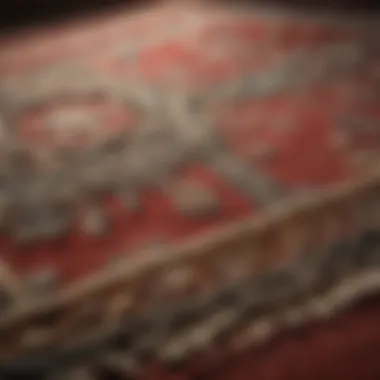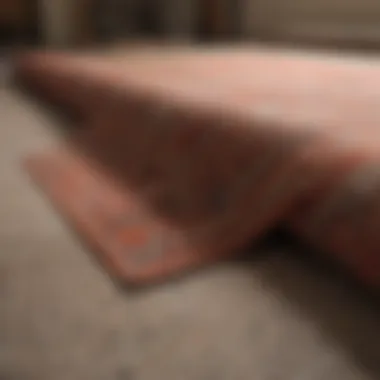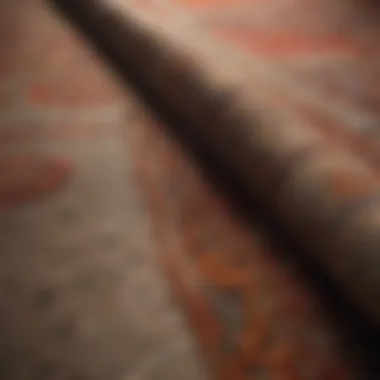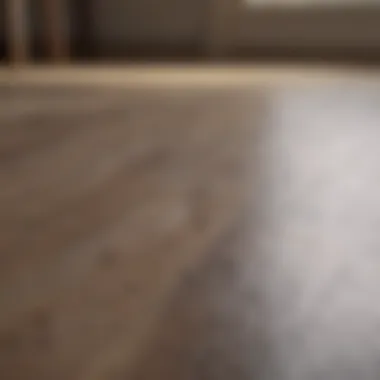Estimating Carpet Replacement Costs: A Detailed Guide


Intro
Replacing carpet involves various considerations that can significantly influence the overall cost. It is not just about the price of the material, but also concerns the intricacies of installation, maintenance, and personal preferences. Homeowners today seek not only durability but also aesthetics that align with their lifestyle.
This guide will explore the factors affecting carpet replacement costs. Our analysis will include material choices, installation expenses, and how regional differences play a role. Readers will gain practical insights into budgeting and additional costs that may arise. A deeper understanding of these topics will empower homeowners and design enthusiasts to make informed decisions regarding their flooring options.
Design Inspiration
Trending Styles
When considering carpet replacement, it is crucial to explore current trends in carpet design. Popular styles today vary from minimalist to lush textures. For instance, loop pile carpets are becoming favored due to their durability and modern appeal. Texture and pattern also play significant roles in contemporary flooring choices.
- Shaggy carpets offer an inviting feel, ideal for comfortable spaces.
- Berber carpets, known for their looped texture, have piqued interest for their durability and aesthetic versatility.
- Patterned carpets can add a unique touch to a room, allowing for creative expression.
Color Palettes
Choosing the right color is just as essential as the style. Neutral shades remain a top choice due to their flexibility. Shades like beige, gray, and taupe seamlessly blend with various decors. Alternatively, bold colors can create focal points in a room. Consider the atmosphere you wish to evoke when selecting colors for your new carpet.
Some popular color themes include:
- Earthy tones – These foster a grounded, natural ambiance.
- Pastels – Soft colors create an airy feel, perfect for tranquil spaces.
- Dark shades – Rich colors offer elegance and depth but may require additional lighting.
Practical Tips
Maintenance & Care
To prolong the life of your new carpet, proper maintenance is non-negotiable. Regular vacuuming is essential to remove dust and dirt. Some carpets may require professional steam cleaning periodically. Always follow manufacturer guidelines for cleaning to avoid damage.
Budgeting & Planning
Budgeting for carpet replacement goes beyond initial material costs. Here are key expenses to consider:
- Material costs – Choose materials fitting your budget while considering longevity.
- Installation fees – Costs vary depending on complexity and the installer’s expertise.
- Additional accouts – This includes potential costs for underlay, removal of old carpet, and disposal fees.
- Maintenance costs – Long-term care should include expected expenses for upkeep every year.
"Investing in quality carpet and proper care can lead to longer-lasting results and satisfaction in your home."
No matter the design vision, taking time to plan your budget around these factors ensures your investment in flooring is wise and effective.
Exploring each aspect thoroughly allows for well-informed decisions for homeowners embarking on the journey of carpet replacement.
Prolusion to Carpet Replacement Costs
Replacing carpet in a home can be a significant decision. The costs associated with it are often complex, influenced by various factors. Understanding these costs helps homeowners make informed choices. This section will explore the nuances of carpet replacement expenses.
Accurate cost estimates can mean the difference between sticking to a budget and unexpected financial strain. Knowledge about the overall costs involved will assist in planning effectively. Factors like material selection, size of the area, and installation types will be addressed.
Understanding Carpet Types
Carpet is available in several types, each with its unique characteristics. The types of carpet include nylon, polyester, wool, and carpet tiles.
- Nylon: Known for its durability and resilience, nylon is a popular choice for high-traffic areas. The price range is generally higher, but the longevity often justifies the cost.
- Polyester: This type tends to be less expensive than nylon. However, its durability is not as high, making it suitable for low-traffic areas.
- Wool: As a natural fiber, wool offers luxury and warmth. Although more expensive, it provides excellent insulation and is environmentally friendly.
- Carpet Tiles: These modular carpets are versatile and easier to install. The cost may vary based on the type of tile used.
Recognizing the different types can lead to better decision-making. Thorough research on the properties of each type will enable the homeowner to select the best fit for their needs and budget.
The Importance of Accurate Cost Estimates


Estimating the total cost of carpet replacement correctly is crucial. An inaccurate estimate could lead to overspending or inadequate funding for the project. Homeowners should consider various elements to arrive at a correct figure.
Factors influencing cost estimates include:
- Material Price: Different carpet materials have variable costs. Knowing the type and its corresponding price will be essential.
- Installation Fees: This could include DIY savings or hiring professionals. Understanding these options can affect the budget.
- Regional Pricing: Carpet costs can differ dramatically by location. Understanding the local market is critical.
Accurate cost estimates may save homeowners from financial strain and ensure a smoother renovation process.
Factors Influencing Carpet Replacement Costs
The costs associated with carpet replacement are impacted by multiple factors. Understanding these elements is essential for homeowners planning a flooring project. Each consideration can significantly affect the final price, which is why dissecting these factors helps in making informed decisions.
Factors such as material quality, size of the carpet, installation methods, and regional labor costs are crucial. Elevating awareness around these topics ensures well-prepared budgeting and prevents unwarranted expenses.
Material Quality and Cost
Selecting the right material is integral. The quality of the carpet directly influences its durability, comfort, and appearance over time.
Nylon
Nylon is a widely favored option for its resilience and durability. It stands up well to wear, making it ideal for high-traffic areas. One of the key characteristics of nylon is its stain resistance, which adds to its appeal for family homes. However, its higher price point compared to other materials may deter some buyers. The unique feature of nylon is its ability to retain color, keeping the carpet looking fresh over years. The disadvantage, though, is that it can be more susceptible to ultraviolet (UV) light, potentially fading in sunny areas.
Polyester
Polyester carpets are known for their softness and vibrant coloration. This material is often more budget-friendly than nylon. The notable aspect of polyester is its ability to resist fading, making it a solid option for homes that receive plenty of natural light. Polyester carpets can be manufactured from recycled materials, making them an eco-friendlier choice. Yet, they don't always have the same durability as nylon, which may lead to faster wear in high-traffic zones.
Wool
Wool carpets boast natural properties that make them a luxurious option. Known for their softness and heat retention, wool is a popular material in colder climates. An attractive feature of wool is its ability to naturally regulate moisture and temperature. Although wool can be on the higher end of price spectrum, it often offers stunning aesthetics and longevity. Some drawbacks include maintenance challenges, as wool carpets can stain more easily, needing specialized cleaning methods.
Carpet tiles
Carpet tiles present a flexible alternative for flooring. They are suitable for both residential and commercial spaces. The primary characteristic of carpet tiles is their modular design, allowing for easy replacement of damaged sections. This feature is cost-effective in the long run, as it can minimize the need for full carpet replacement. However, laying down carpet tiles may require a more sophisticated installation than broadloom carpets, and there might be a visual uniformity issue if not installed properly.
Carpet Size and Area Calculation
The size of the carpet directly influences the overall cost. Accurately measuring the space intended for flooring is critical. Homeowners should assess the dimensions of the room, considering any irregularities or cutouts. Square footage needs translating into material costs, and miscalculations can lead to overspending or buying too little. Knowing your total carpet area will substantially guide your budget planning.
Labor Costs and Installation Methods
The cost of labor is another pivotal consideration when replacing carpets. The choice between do-it-yourself (DIY) installation and hiring professionals affects the overall expenditure.
DIY installation
Engaging in DIY installation can significantly lower costs, appealing to budget-conscious homeowners. The key characteristic of DIY installation is the direct control over time and materials. For those who are handy, this may also be a rewarding project. Nevertheless, the potential disadvantage lies in the lack of professional expertise, which might lead to mistakes that could outweigh the savings.
Hiring professionals
On the other hand, hiring professional installers provides peace of mind and guarantees quality. Professionals bring skills that ensure precise fitting and a finished product that looks polished. Their expertise can save time and prevent issues that might arise from incorrect installation. However, the drawback is the added expense, which can be a significant factor for many homeowners.
Regional labor differences
Labor costs vary widely based on geographic location. Urban areas often have higher costs compared to rural locales. Understanding regional labor differences helps in accurate budget forecasting. It is beneficial to obtain several quotes from local contractors to gauge the fair market rate in your region. Ignoring these differences can lead to misjudgments in estimated costs.
Cost Breakdown of Carpet Replacement
Understanding the cost breakdown of carpet replacement is essential for anyone considering a flooring update. It enables homeowners to make informed decisions about their purchases and anticipate total expenses effectively. This section will explore average carpet prices, labor expenses, and additional costs, providing a framework for better budgeting and planning.


Average Carpet Prices per Square Foot
Carpet pricing typically varies depending on its material, style, and brand. On average, homeowners can expect to pay between $2 to $10 per square foot for carpet. Premium varieties can reach higher prices, especially for wool or specialized carpets. It's critical to remember that cheaper options often do not offer the same durability or aesthetics as higher-end alternatives.
- Nylon: This is a popular choice for its resilience and stain resistance, priced usually around $3 to $7 per square foot.
- Polyester: Often praised for its softness and vivid color options, it generally costs between $2 to $5 per square foot.
- Wool: A luxurious option with a price range of $5 to $10 per square foot or more, this material is eco-friendly and durable but requires more maintenance.
- Carpet Tiles: These can be a versatile and cost-effective option, with prices ranging from $1 to $6 per square foot.
Labor Expenses for Installation
Labor costs can significantly impact the total expenditure of carpet replacement. Typically, these costs can be calculated as an additional $1 to $4 per square foot, depending on the complexity of the installation and the geographical area. Factors affecting labor expenses include:
- DIY Installation
Choosing to install the carpet personally can save money. However, a lack of experience might lead to mistakes that could inflate costs later. - Hiring Professionals
Hiring skilled installers ensures proper fitting, which may prevent future issues. While this option may be more expensive, it often results in better aesthetics and prolonged carpet life. - Regional Labor Differences Prices vary by location. Urban areas typically have higher labor rates compared to rural regions, which can affect the total installation budget.
Additional Costs to Consider
When budgeting for carpet replacement, several extra expenses may arise. Understanding these costs is vital for calculating the true total price.
Removal of old carpet
Removing existing carpet is an essential first step. This process involves labor and potentially disposal fees. The key aspect of this is its role as a preparatory measure. Removing old carpet not only gives a fresh start for the new installation but also helps in detecting underlying issues with the subfloor. Expect costs between $0.50 to $2 per square foot for removal.
Underlay materials
Underlay materials, or padding, play a significant role in the longevity, comfort, and performance of the carpet. Ideal padding enhances the carpet's feel underfoot and provides insulation. The average cost of underlayment ranges from $0.30 to $1 per square foot, depending on the quality. Choosing appropriate underlay material can optimize your investment in new carpet.
Transition strips
Transition strips are necessary for a smooth transition between different flooring types and areas within a home. They maintain aesthetics while either bridging height differences or protecting edges. The cost for transition strips is generally $1 to $4 per linear foot, based on the material and style. Investing in these strips helps avoid wear and tear at the edges of the carpet, making them a worthwhile consideration.
Regional Variations in Carpet Costs
Understanding the regional variations in carpet costs is essential for homeowners and interior design enthusiasts. These variations stem from a mix of factors including local economies, availability of materials, and labor costs. Each region in the United States has its own pricing structures influenced by demand, logistics, and even climate considerations. By recognizing these differences, individuals can make more informed decisions that align with their budget and aesthetic aspirations.
Urban vs. Rural Pricing Structures
Urban areas typically exhibit higher carpet prices compared to rural locations. This difference arises due to increased demand in cities, where people are willing to invest more in home aesthetics. Moreover, urban centers often offer a wider selection of high-end carpet materials, which can drive costs up further. Conversely, rural areas may have lower prices due to less competition and reduced overhead costs for retailers. Homeowners should consider these factors when planning their budget and choosing where to purchase their carpeting.
Comparative Analysis of Cost by Region
Northeast
The Northeastern United States often experiences higher carpet prices. This can be attributed to a dense population and a diverse selection of luxury carpet options. Cities like New York and Boston have a flourishing home renovation market that drives prices. Additionally, the colder climate requires carpets that offer comfort and insulation, which may come at a premium. While costs may be higher, homeowners tend to find durable and stylish options that justify the investment.
Midwest
Carpet prices in the Midwest are generally more moderate compared to the Northeast. The region's economy allows for competitive pricing, largely due to the presence of large retailers and manufacturers. Here, homeowners often have access to varied styles without a significant markup. However, the preference for budget-friendly materials can limit choices. Midwestern homes often prioritize practicality, which makes this area favorable for cost-conscious buyers.
South
The South is characterized by a unique blend of affordability and style. Prices tend to be lower due to a less dense population and competitive markets. The warmer climate often calls for lighter materials, which are less expensive. Homeowners in this region can find a wide range of carpets that meet both budget and aesthetic needs. The balance between affordability and quality often makes the South a popular choice for carpet replacement.
West
In the Western United States, including states like California and Washington, carpet costs can vary widely. Major metropolitan areas see high prices driven by luxury demands and trendy designs. However, rural regions like those in Montana offer more reasonable options. Key considerations in the West include the outdoor lifestyle that influences carpet choices, particularly for durability and maintenance. While urban areas are costly, the region also presents various budget-friendly alternatives.
Budgeting for Carpet Replacement


Budgeting for carpet replacement is essential for homeowners. It involves careful planning and understanding of various cost factors. A realistic budget serves not just as a financial tool but also as a guide for decision-making. Various elements will affect your budget, such as the cost of materials, labor, and any additional features you may want to include.
Creating a Realistic Budget
A realistic budget starts with an assessment of your financial situation. Take stock of your expenses and available funds. Knowing how much you can afford is the first step to determining which carpet options are viable for you. Consider the size of the area you wish to cover, as this will significantly influence material and labor costs. To create a solid budget, break down the overall expenses into categories:
- Materials: Different carpet types will have varying costs.
- Labor: Whether you are hiring professionals or going the DIY route will impact total costs.
- Additional Items: Underlay, removal of old carpets, and transition strips can add to expenses.
By documenting all expected costs, you can avoid surprises and make informed decisions.
Identifying Financial Assistance Options
Understanding your financial options can ease the burden of upfront costs. Homeowners have several avenues available to help finance their carpet replacement projects.
Homeowner loans
Homeowner loans can be a practical choice for financing your carpet replacement. These loans often have favorable interest rates compared to credit cards. One key characteristic is that they are usually secured against the property, which may result in lower monthly payments. This financing option allows homeowners to spread costs over time, making budgeting easier. However, securing a homeowner loan may take longer, as lenders will scrutinize your credit history and overall financial situation.
Credit options
Using credit options is another way to finance carpet replacement. Credit cards or personal loans can provide immediate access to cash for your project. One significant benefit is convenience; you can often get approval quickly. However, reliance on credit can lead to high-interest payments if not managed carefully. Use this avenue wisely to avoid financial strain in the long term.
It is crucial to evaluate both homeowner loans and credit options to determine which best suits your financial landscape.
Overall, taking time to carefully plan your budget and explore financial assistance can lead to smarter decisions in carpet replacement.
Long-term Considerations
When homeowners consider carpet replacement, they often focus on immediate costs without fully appreciating the long-term implications. Long-term considerations are essential in informing choices that affect both financial stability and home comfort in the future. In this section, we will explore the significance of durability and maintenance costs, as well as how the right carpet choices impact resale value.
Durability and Maintenance Costs Over Time
Carpet durability is a crucial factor in calculating long-term costs. Different materials offer various levels of resilience and longevity. For example, nylon carpets generally provide higher durability compared to polyester and wool options. Over time, carpets undergo wear and tear, influenced by foot traffic, cleaning methods, and environmental conditions.
Homeowners must consider potential maintenance costs that will accrue over the carpet's lifespan. Regular cleaning could include professional steam cleaning, which may vary in price based on region and company selection. Daily wear may lead to the need for patching or replacement of sections. Additionally, the choice of an appropriate underlay can enhance the life expectancy of the carpet and improve comfort. Opting for quality materials initially can lead to lower maintenance expenses in the long run.
"Investing in a durable carpet can save homeowners money on replacements and repairs down the line."
Thus, carefully evaluating durability and maintenance should feature prominently in your decision-making process when choosing new carpet.
How Carpet Choices Affect Resale Value
Selecting the right carpet can significantly affect the resale value of your home. Buyers often perceive value in aesthetics, functionality, and, notably, durability. For instance, high-quality materials like wool or high-end nylon might attract buyers looking for luxurious amenities. In contrast, cheaper alternatives might raise red flags regarding long-term performance.
Furthermore, carpeting trends can vary from year to year. It's prudent to align your choices with current styles while also considering neutrality. Neutral-colored carpets often appeal to a broader audience, creating a more inviting atmosphere for potential buyers.
Additionally, implementing carpets that contribute to energy efficiency may also incline buyers favorably. For instance, carpets with good insulation qualities can help maintain home temperature, resulting in lower energy costs.
Finale
The conclusion of this article provides a critical synthesis of the considerations surrounding carpet replacement costs. Understanding these costs is paramount for homeowners and interior design enthusiasts alike. It not only affects immediate financial decisions but also influences long-term planning for maintenance and potential resale value of a property.
Recap of Key Cost Factors
In reviewing the key cost factors discussed, it is evident that multiple elements contribute to the final price of carpet replacement:
- Material Quality: The choice of carpet fibers such as nylon, polyester, and wool heavily impacts pricing and longevity. Higher-quality materials typically yield better durability and maintenance costs.
- Size and Area: Accurate measurement of the area requiring carpeting is essential. Neglecting this step can lead to over budget scenarios.
- Installation Method: Whether choosing a DIY approach or hiring professionals can also dramatically shift total costs.
- Regional Differences: Urban areas may have higher labor costs compared to rural locations, which can play a significant role in overall expenses.
Offering clarity on these factors empowers homeowners to make informed decisions.
Final Thoughts on Carpet Replacement Investment
Investing in carpet replacement is not merely an aesthetic choice; it also encompasses practical considerations. The upfront costs might appear substantial. However, when integrated with potential benefits such as increased home value and improved livability, the investment is worthwhile. Homeowners need to evaluate durability against cost. An expensive carpet might lead to savings in maintenance over time. Additionally, considering resale value can further guide the decision-making process.















